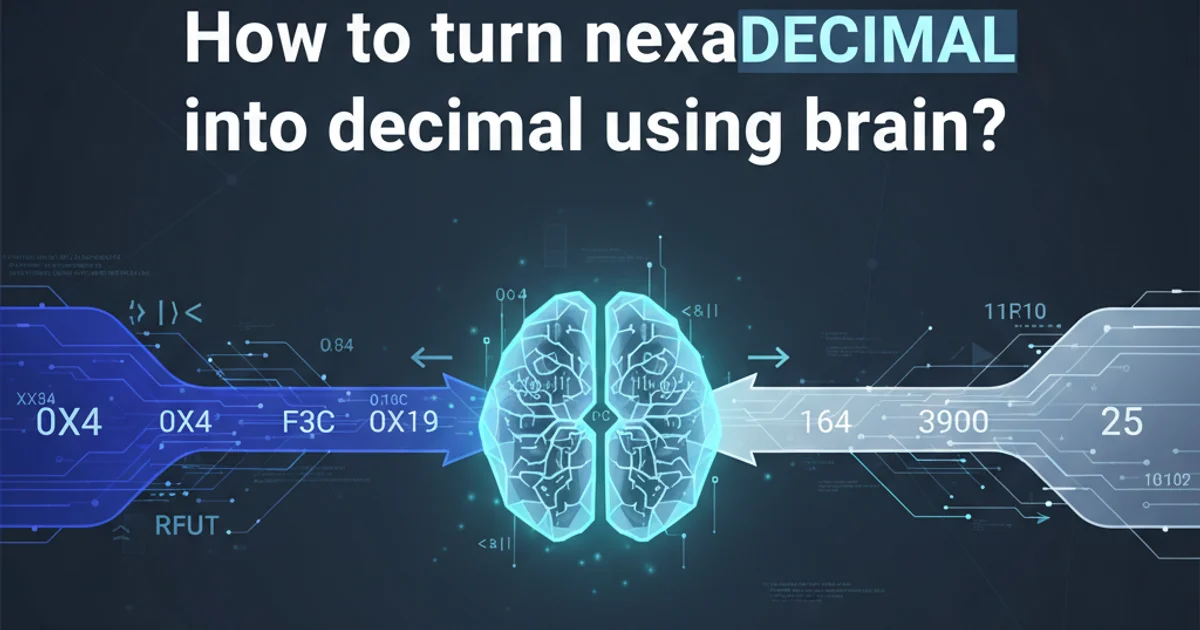How to turn hexadecimal into decimal using brain?
Categories:
Converting Hexadecimal to Decimal: A Step-by-Step Guide

Unlock the mystery of hexadecimal numbers by learning how to convert them to their decimal equivalents using a clear, methodical approach.
Hexadecimal (base-16) is a number system commonly used in computing and digital electronics. It provides a more compact representation of binary numbers, making it easier for humans to read and write large values. While computers natively understand binary, we often encounter hexadecimal in contexts like memory addresses, color codes (e.g., #FF0000 for red), and data dumps. Understanding how to convert hexadecimal to decimal (base-10) is a fundamental skill for anyone working with these systems.
Understanding Number Systems: Hexadecimal vs. Decimal
Before diving into the conversion process, let's briefly review the two number systems involved. Decimal, our everyday system, uses ten unique digits (0-9) and is a base-10 system, meaning each digit's position represents a power of 10. For example, 123 in decimal is 1 * 10^2 + 2 * 10^1 + 3 * 10^0.
Hexadecimal, on the other hand, is a base-16 system. It uses sixteen unique symbols: 0-9 for the first ten values, and A-F to represent values 10-15. Each digit's position in a hexadecimal number represents a power of 16. This positional value is key to the conversion process.
flowchart TD
A[Decimal Digits] --> B{0-9}
C[Hexadecimal Digits] --> D{0-9}
D --> E{A (10)}
E --> F{B (11)}
F --> G{C (12)}
G --> H{D (13)}
H --> I{E (14)}
I --> J{F (15)}
B & J --> K[Base-10 vs. Base-16]Comparison of Decimal and Hexadecimal Digits
The Positional Value Method
The most straightforward way to convert a hexadecimal number to its decimal equivalent is by using the positional value method. This method involves multiplying each hexadecimal digit by the corresponding power of 16, based on its position, and then summing the results. Let's break down the steps:
- Assign Decimal Values to Hex Digits: Remember that A=10, B=11, C=12, D=13, E=14, F=15. Digits 0-9 retain their decimal values.
- Identify Positional Powers of 16: Starting from the rightmost digit (least significant digit), assign powers of 16. The rightmost digit is
16^0, the next is16^1, then16^2, and so on. - Multiply and Sum: Multiply the decimal value of each hex digit by its corresponding power of 16. Then, add all these products together to get the final decimal number.
Example: Converting '2F' to Decimal
Let's apply the positional value method to convert the hexadecimal number 2F to decimal.
1. Step 1: Break Down the Hex Number
The hexadecimal number is 2F. It has two digits: '2' and 'F'.
2. Step 2: Assign Positional Powers of 16
Starting from the right:
- 'F' is in the
16^0position. - '2' is in the
16^1position.
3. Step 3: Convert Hex Digits to Decimal
- 'F' in hexadecimal is 15 in decimal.
- '2' in hexadecimal is 2 in decimal.
4. Step 4: Multiply and Sum
- For 'F':
15 * 16^0 = 15 * 1 = 15 - For '2':
2 * 16^1 = 2 * 16 = 32
Now, sum these products: 15 + 32 = 47.
5. Result
Therefore, the hexadecimal number 2F is equal to 47 in decimal.
Example: Converting '1A3' to Decimal
Let's try a slightly longer hexadecimal number: 1A3.
1. Step 1: Break Down the Hex Number
The hexadecimal number is 1A3. It has three digits: '1', 'A', and '3'.
2. Step 2: Assign Positional Powers of 16
Starting from the right:
- '3' is in the
16^0position. - 'A' is in the
16^1position. - '1' is in the
16^2position.
3. Step 3: Convert Hex Digits to Decimal
- '3' in hexadecimal is 3 in decimal.
- 'A' in hexadecimal is 10 in decimal.
- '1' in hexadecimal is 1 in decimal.
4. Step 4: Multiply and Sum
- For '3':
3 * 16^0 = 3 * 1 = 3 - For 'A':
10 * 16^1 = 10 * 16 = 160 - For '1':
1 * 16^2 = 1 * 256 = 256
Now, sum these products: 3 + 160 + 256 = 419.
5. Result
Therefore, the hexadecimal number 1A3 is equal to 419 in decimal.
int('2F', 16) to get 47.